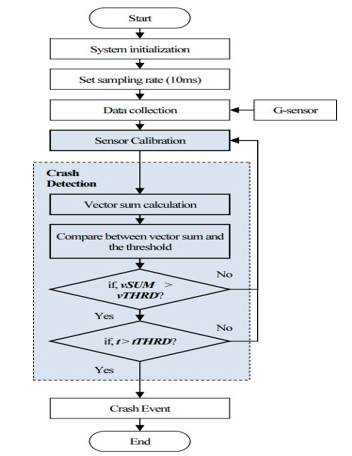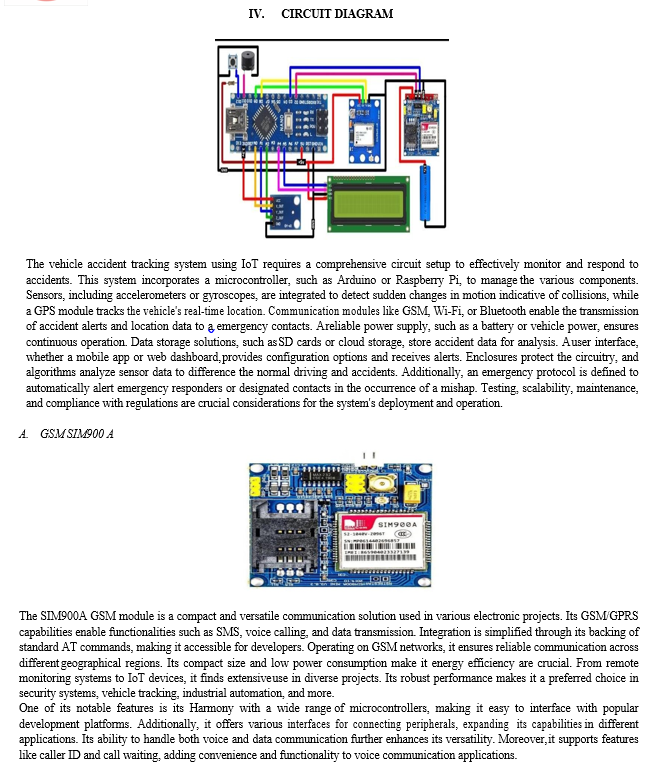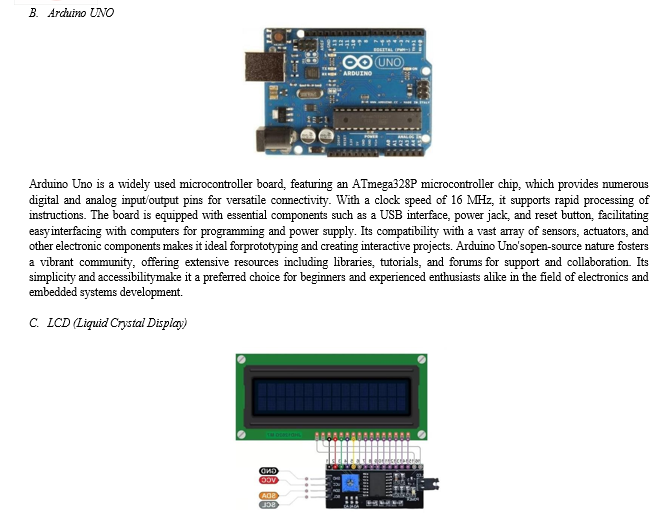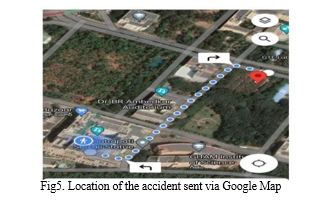Ijraset Journal For Research in Applied Science and Engineering Technology
- Home / Ijraset
- On This Page
- Abstract
- Introduction
- Conclusion
- References
- Copyright
Novel Approach for Vehicle Accident Tracking using IoT
Authors: Mohammed Shafiulla, Kanni Abhishek, Chetan Barole, Adarsh H S, Meti Amith Kumar
DOI Link: https://doi.org/10.22214/ijraset.2024.62665
Certificate: View Certificate
Abstract
In recent years, there has been significant interest in integrating Internet of Things (IoT) technology into vehicle safety systems to enhance emergency response capabilities and road safety. This paper introduces a comprehensive Vehicle Accident Tracking System (VATS) that utilizes IoT principles. The proposed system incorporates various sensors and communication devices installed within vehicles to monitor their status and detect potential accidents in real-time. When an accident is detected, the system automatically triggers an alert mechanism, notifying relevant stakeholders such as emergency services and fleet managers. Key components of the VATS include accelerometers, GPS modules, and onboard communication units, which work together to provide precise accident geospatial data and vehicle condition data. The system utilizes cloud-based platforms for data storage and processing, ensuring seamless integration with existing infrastructure and scalability. By continuously monitoring and analyzing vehicle telemetry data, the VATS facilitates proactive accident prevention measures and post-accident analysis. Additionally, it offers benefits such as reduced emergency response times, improved accident documentation for insurance claims, and enhanced overall road safety. Privacy and security concerns are addressed through encryption protocols and access control mechanisms to protect sensitive information. Overall, the Vehicle Accident Tracking System presented in this paper represents a significant advancement in leveraging IoT technology to mitigate the impact of accidents on roadways, thereby contributing to a safer and more efficient transportation ecosystem.
Introduction
I. INTRODUCTION
The advent of IoT technology has revolutionized various industries, and one area where its potential shines is in road safety through a Vehicle Accident Tracking System. By integrating IoT sensors and devices into vehicles, this system is poised to revolutionize the way accidents are detected, reported, and responded to. It operates by constantly monitoring key metrics such as acceleration, deceleration, and changes in direction, enabling it to promptly identify and flag potential accidents or collisions. the occurrence of a mishap, the system swiftly transmits crucial data, impact severity, and status, to emergency responders and relevant authorities. This real-time information empowers emergency services to dispatch assistance swiftly, potentially reducing response times and minimizing . Moreover, the system's ability to collect and store cloud facilitates comprehensive accident records, enabling authorities to analyze trends, identify risk factors, and implement targeted safety measures. Furthermore, post- accident investigations can benefit from detailed event logs and evidence given by the system, aiding in determining liability and improving accountability. Overall, this devices harnesses the power of IoT to enhance road safety, mitigate risks, and save lives on our roads.
A. Objectives
To Implement Real-time Monitoring and real-time tracking of vehicles to promptly detect and respond to accidents
To Ensure Accurate Accident Detection Implement sensors to detect sudden accelerations, decelerations, or collisions indicative of accidents.
To Facilitate Emergency Response Automatically generate and transmit alerts to relevant authorities, emergency services, and designated contacts The occurrence of a mishap.
To Develop a Easy to use for both vehicle owners and administrators to access and manage the system.
II. LITERATURE SURVEY
In paper [1], the author addresses the critical issue of increasing road accidents in Bangladesh. The authors introduce a comprehensive system utilizing Arduino Nano, SIM808, and MPU6050 modules to detect and confirm vehicle accidents. Motivated by a tragic incident, the system aims to reduce response time in emergencies by automatically notifying authorities and nearby help centers via SMS, providing the exact accident location through GPS.
The proposed system incorporates various sensors and algorithms to detect anomalies in acceleration, deceleration, and angular offset, ensuring a wide range of accident scenarios are covered. The paper concludes with the system's limitations and outlines future enhancements, emphasizing the potential to save lives by efficiently utilizing post-accident time for prompt response and aid coordination.
In paper [2], An Arduino based automated vehicle accident detection and messaging system The paper addresses the pressing issue of increasing road accidents in Bangladesh. The authors, students from the United International University, introduce a comprehensive solution that utilizes Arduino NANO, SIM808, and MPU6050 modules for real-time accident detection. Motivated by a tragic incident, the system aims to provide immediate aid by detecting accidents in various scenarios, such as sudden accelerations, decelerations, and angular offsets. The proposed system uses GPS and GSM technologies to send automated SMS notifications containing the precise accident location to authorized contacts. By incorporating features like a cancel option for non-fatal situations and overcoming limitations to overcome accidents underwater, the authors present a robust system with the potential to significantly reduce response time and save lives. The paper concludes with a focus on future improvements, emphasizing enhanced notification systems and collaboration with response institutions for more efficient postaccident interventions.
In paper [3], Blackspot Alert and Accident Prevention System The paper tackles the critical issue of road accidents in India, where a death occurs every 4 minutes. The authors propose a solution through a GPS-based Portable software that alerts drivers about historically reported accident blackspots. The system utilizes a cloud database to store blackspot locations and their speed limits, with the mobile app providing voice notifications 500 meters before reaching a blackspot. Integrated with a microcontroller, the system takes control of the vehicle's accelerometer, automatically reducing speed to match the designated limit in the blackspot zone. The technology stack involves smartphones, Android development, GPS, accelerometers, and cloud computing. The paper discusses related work, presents the proposed system's architecture, and demonstrates positive results in reducing vehicle speed in simulated blackspot scenarios. Future enhancements could involve accident reporting and emergency services integration
In paper [4], held in December 2020, addresses the critical issue of car accidents through the design of a smart system utilizing Internet of Things (IoT) technology. Recognizing that many accidents result from driver unawareness and uncontrolled speed, the proposed system employs an Arduino-based collision detection and tracking system. Integrated with ultrasonic, vibration, GPS, and GSM modules, the system monitors the distance between vehicles, providing real-time alerts to drivers through LED indicators and a buzzer. The occurrence of a mishap, the system automatically notifies family members and the nearest rescue team with the vehicle's GPS location. Additionally, the paper discusses the system's potential for theft prevention and tracking using GPS technology. The proposed system demonstrates promise in enhancing road safety and emergency response capabilities.
In paper [5], Multi-Sensor Multi-Vehicle (MSMV) Localization and Mobility Tracking for Autonomous Driving The paper presents a comprehensive framework for enhancing vehicle localization and mobility tracking in autonomous driving scenarios. The proposed system integrates data from (IMUs), and advanced sensing systems such as LiDAR and cameras, to improve accuracy and robustness. The framework employs a two-layer structure, comprising global and local filters, to fuse information from multiple vehicles. Notably, it considers communication delays during information sharing via Vehicle-to-Vehicle (V2V) links. The authors demonstrate through simulations that the proposed framework significantly improves accuracy and robustness compared to traditional methods, making it valuable for applications like autonomous vehicles and intelligent transportation systems. This research has implications for enhancing the performance of accident detection systems by providing more precise and reliable localization and mobility tracking information.
In paper [6], Analysis of Vehicle Activities and Live Streaming using IoT The paper by Philo Stephy A, Preethi C, and K. Mohana Prasad presents a comprehensive incident detection system in vehicles. The Suggested framework utilizes IoT technology, including Detectors like GPS, cameras, and external sensors like vibration and fuel sensors. The system aims to analyze accidents by tracking vehicle activities and, accident scenario, sends an notification to pre-stored contacts. Live streaming Of the collision scene is made possible through cloud computing.
The system integrates image processing techniques, background subtraction, and face detection to optimize the Study of accidents. Additionally, Array of sensors, including a fuel sensor and vibration analysis sensor, Support to a holistic the accident management protocol prevention. The paper discusses the existing system's drawbacks and presents a novel system architecture, detailing the hardware implementation. The authors also describe the proposed system's components, including Raspberry Pi, webcam, and streaming capabilities. The findings and discussions highlight the effectiveness of the Setup in accident detection, video capture, and live streaming. Overall, the paper provides a valuable foundation for the development of an collision detection system using advanced IoT technologie
III. METHODOLOGY
- Libraries: The code includes several libraries for different components such as Liquid Crystal_I2C for the display panel, AltSoftSerial for the GPS module, TinyGPS++ for GPS parsing, and SoftwareSerial for interact with the cellular module.
- Pin Definitions: Defines the pins used for various components like GSM module (RX, TX), GPS module (RX, TX), buzzer, button, and accelerometer sensor.
- Initialization: - Initializes serial is interact with the Arduino, Cellular module, and GPS module.
- Initializes the Display panel
- Initializes variables and sets up initial configurations for the Cellular module (AT commands).
4. Impact Detection (Impact() function)
- Reads accelerometer sensor values and calculates magnitude.
- Determines if an impact is detected the magnitude exceeding a certain threshold.
- Sets a flag (updateflag) when an impact is detected.
5. Main Loop (loop() function)
- Calls the Impact() function to check for impacts periodically.
- If an impact is detected (updateflag is set), it triggers actions like activating the buzzer, displaying a message on the LCD screen, and initiating an alert procedure.
- It’s checks the data from the cellular module module and processes it accordingly.
- Resets the impact detection if a button press is detected.
6. Parsing GSM Data (parseData() function)
- Parses incoming data from the Cellular module
- Handles SMS reception and processes specific commands embedded within the SMS messages, like requesting GPS coordinates.
7. GPS Handling (getGps() function)
- Retrieves GPS coordinates from the Location tracking module
- Formats the GPS data for further use (e.g., sending SMS with location data).
8. Text and Phone Functions
- Includes functions to send SMS messages (sendSms()) and make emergency calls (makeCall()).
- SMS messages include the identified impact and GPS Organize.
9. Utility Functions
- Includes a utility function (SendAT()) to sendAT commands to the Cellular module and wait for responses.i
A. Algorithm
- Step 1: Sensor Calibration
Calibrate the g-sensor intrinsically and extrinsically.
Rectify the input data using complementary filters.
2. Step 2: Data Collection
Set the sampling rate (e.g., 10ms).
Collect information from the g-sensor.
Apply sensor calibration to the collected data.
3. Step 3: Purposed Crash Detection
Calculate the vector sum (vSum) of the calibrated x, y, z values using Equation (6).
vSum = √((x2 - x1)^2 - (y2 - y1)^2 - (z2 - z1)^2)
Compare the calculated vSum with a set limit value (vTHRD).
If vSum > vTHRD, it’s a chance for crash event.
Consider time in crash detection by calculating the difference between the current time and the time when
vSum > vTHRD occurred.
t = current time - time when vSum > vTHRD occurred
Determine a time threshold (tTHRD) according to the sampling rate and calibration count.
tTHRD = sampling rate * calibration count * n
If both conditions (vSum > vTHRD && t > tTHRD) are satisfied, declare a crash event.
4. Step 4: Event Handling
Record crash event data.
Initiate appropriate actions (e.g., video recording, system log file creation, alarm sound).
5. Step 5: Evaluation and Adjustment
Evaluate the Execution of the crash detection algorithm under various scenarios.
Adjust threshold values (vTHRD, tTHRD) based on experimental results to improve detection accuracy.
6. Step 6: Conclusion
Conclude the effectiveness of the proposed crash detection algorithm.
Consider further evaluations and refinements for future development.
Purposed flow chart of crash detection



A display panel, commonly known as LCD, derives its definition from the unique combination of two states of matter solid and liquid. By utilizing liquid crystal technology, LCD screens produce a visually stunning image that is more used in laptops, televisions, cell phones, and portable video games. Unlike the bulky cathode ray tube (CRT) technology, LCD's ultra-thin composition by its multiple layers, including polarized panel filters and electrodes. LCD technology is a popular choice for displaying images in electronic gadgets like mini computers and notebooks. As light passes through a lens, it interacts with the liquid crystal layer, creating a grayscale image that is then combined with colored light to produce a vivid, high- quality image on the screen. In summary, LCD technology offers a sleek and efficient alternative to traditional display screens.
V. WORKING PRINCIPLE
The system utilizing IoT operates through a network of sensors that continuously observe the vehicle's movements and conditions. Arduino Uno serves as the main processing unit, collecting and analyzing data from these sensors in real-time. Unusual patterns indicative of accidents trigger the setup to confirm severity against predefined thresholds. Once confirmed, the system initiates alerts, notifying emergency contacts via SMS and pinpointing the crash sit eusing GPS coordinates. Additionally, precautions such as activating hazard lights can be automated. Detailed accident data, including timestamp, location, and impact force, is logged either locally or on a cloud server for subsequent analysis. Prompt deployment of Crisis response teams. responders is facilitated, and post-accident analysis informs future safety enhancements, ensuring continuous improvement of thesystem's efficiency.
VI. SIMULATION RESULTS
The vehicle crash tracking system simulation demonstrated Precise incident identification through sensor data analysis. Arduino Uno efficiently processed real-time information, triggering SMS alerts promptly upon accident confirmation. GPS coordinates accurately pinpointed accident locations, facilitating rapid emergency response. Automated safety measures, such as hazard light activation, were consistently initiated, bolstering on-road safety. Detailed logging of accident data provided the system optimization


IV. ACKNOWLEDGEMENT
The satisfaction that accompanies the successful completion of research and development of the iot application “NOVEL APPROACH FOR VEHICLE ACCIDENT TRACKING USING IOT” would be incomplete without the mention of people who made it possible, whose noble gesture, affection, guidance, encouragement, and support crowned my efforts with success. It is a privilege to express gratitude and respect to all those who provided inspiration in the completion of this research and are extremely grateful to our respective Guides Mr. Md. Shafiulla for the noble gesture, support coordination, and valuable suggestions given for the completing of the research, also are thankful to Dr. R. N. Kulkarni, H.O.D Department of CSE, for his coordination and insightful advice that were given which helped in achieving this study
Conclusion
The execution of a Vehicle Accident Tracking System utilizing IoT technology offers preemptive road safety strategy and accident management. By integrating sensors and GPS technology, real-time monitoring and notify systems capable of promptly identifying and addressing accidents swiftly. This system enhances emergency response times, life-saving and minimizing property damage. Furthermore, the collected data can be analyzed to identify accident-prone areas, facilitating targeted precautions and infrastructure improvements. Overall, the Execution of this system promotes a safer and more efficient transportation network, aligning with the global goal of reducing road accidents and fatalities
References
[1] N. Ahmmed, N. J. Jenny, M. Fowziya Akther Houya, A. I. Binte Alam, and M. Adnan Arefeen presented a paper titled \"VADet: An Arduino-Based Automated Vehicle Accident Detection and Messaging System\" at the 2019 1st International Conference on Advances in Science, Engineering, and Robotics Technology (ICASERT) in Dhaka, Bangladesh. [2] R. Rishi, S. Yede, K. Kunal, and N. V. Bansode authored the paper \"Automatic Messaging System for Vehicle Tracking and Accident Detection,\" which was presented at the 2020 International Conference on Electronics and Sustainable Communication Systems (ICESC) in Coimbatore, India. [3] R. k. Thangavel, S. Athithan, S. Sarumathi, M. Aruna and B. Nithila, \"Blackspot Alert and Accident Prevention System,\" 2019 10th International Conference on Computing and Communications and Networking Technologies (ICCCNT), Kanpur, India, 2019, [4] M. Dewan and A. Agarwal, \"IOT Based Smart Vehical Monitoring and Tracking System,\" 2020 9th International Conference System Modeling and Advancement in Research Trends (SMART), Moradabad, India, 2020 [5] P. Yang, D. Duan, C. Chen, X. Cheng and L. Yang, \"Multi-Sensor Multi-Vehicle (MSMV) Localization and Mobility Tracking for Autonomous Driving,\" in IEEE Transactions on Vehicular Technology Dec. 2020 [6] P. S. A., P. C. and K. M. Prasad, \"Analysis of Vehicle Activities and Live Streaming using IOT,\" 2019 International Conference on Communication and Signal Processing (ICCSP), Chennai, India, 2019
Copyright
Copyright © 2024 Mohammed Shafiulla, Kanni Abhishek, Chetan Barole, Adarsh H S, Meti Amith Kumar. This is an open access article distributed under the Creative Commons Attribution License, which permits unrestricted use, distribution, and reproduction in any medium, provided the original work is properly cited.

Download Paper
Paper Id : IJRASET62665
Publish Date : 2024-05-24
ISSN : 2321-9653
Publisher Name : IJRASET
DOI Link : Click Here
 Submit Paper Online
Submit Paper Online

